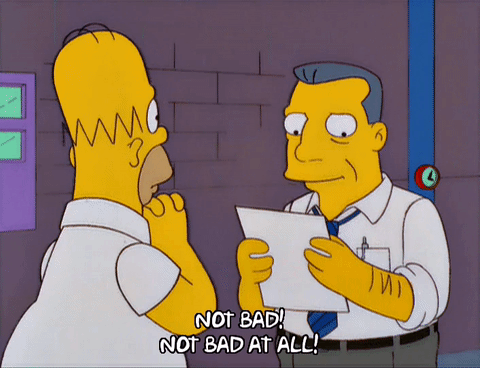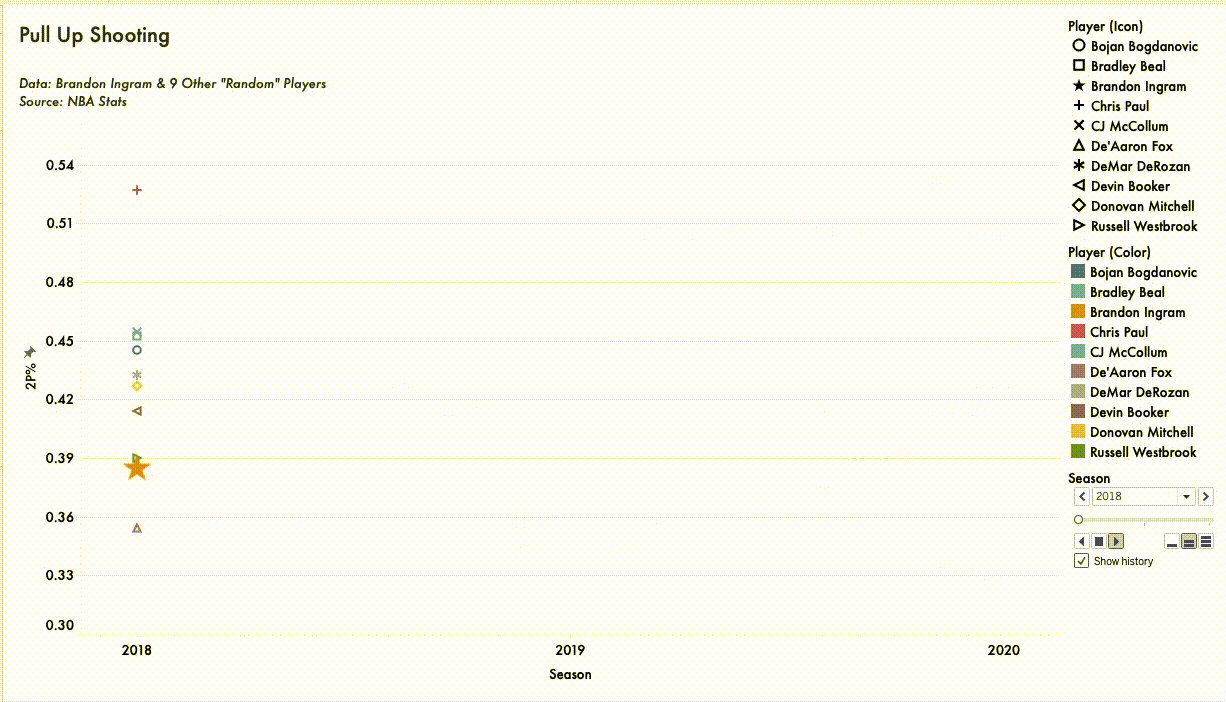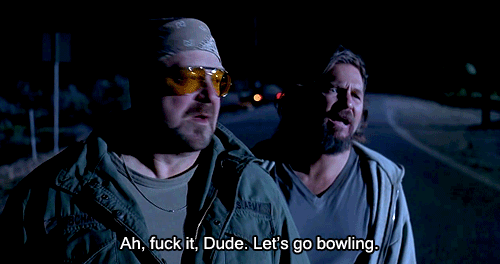Free Agent Profile: Brandon Ingram
Shwinnypooh: The 2019-20 season was a massive failure for the New York Knicks. Shocking, I know. Steve Mills chose to trade away the former future franchise player to be, Kristaps Porzingis, at the 2018-19 trade deadline in order to clear the team’s cap sheet of salary commitments to Tim Hardaway Jr. and Courtney Lee. The move gave the Knicks space for two max players heading into a summer 2019 free agent class loaded with stars, and also yielded two first round picks and an athletic, exciting point guard prospect in Dennis Smith Jr.
Armed with the most cap space in the league the Knicks went in with high hopes, and came out with Julius Randle. Classic Knicks. LOL Knicks, even.
Less Knicksy, however, was that despite the deluge of spending on a smorgasbord of mid, the Mills and Scott Perry braintrust managed to hold their nerve well enough not to tie up their flexibility long-term. Aside from Randle, who signed a two-year contract, the rest of the Knicks’ free agent supermarket dash consisted of what are all, essentially, one-year deals.
The point being, we can work ourselves into a free agent frenzy again.
While the Knicks were having a miserable campaign, Brandon Ingram was having a superlative one in New Orleans. One of the main centerpieces in the return package for the Pelicans in the Anthony Davis trade, Ingram transformed from an exciting young slasher into a bonafide three-level star scorer and wing creator.
In 56 games this season, Ingram averaged 24.3 points, 6.3 rebounds, and 4.3 assists on 46.6/38.7/85.8 splits en route to his first All-Star berth in a loaded Western Conference field. Not bad, not bad at all.
Far more important for his bank account is that his breakout season came right on the eve of his first foray into free agency. Given his personal frustrations at not getting an extension done prior to the season, it’s nearly certain it’s worked out for the best for him, as he’s nearly guaranteed to receive a max contract whenever this offseason takes place.
So is there any chance the Knicks could pry Ingram away from the Pelicans’ beaks? It’s a complex issue, and that’s why I brought Jon Schulman along for the ride.
I feel vindicated by Ingram’s breakout this season on a personal level as I thought — and argued several times — that he would have broken out faster his last season in Los Angeles, but got off to a slow start as he adjusted to playing in a LeBron-centric offense. Even then, his last couple of months prior to the blood clot issue that ended his season early were extremely promising, to the point that I was even happy to trade a future Knicks pick for him last summer.
Alas, the Knicks didn’t listen to me, and Ingram broke out, albeit to a level even I wouldn’t have predicted. He really took a leap across the board as a scorer, shooter, ball handler, and passer at the perfect time, at least for himself. For the Knicks? Well, it becomes far more complex to hypothesize a scenario where Ingram brings his talents to the Big Apple next season. Before we get into that, what did you think of Ingram over his first couple of season and what changed for him this season? Perhaps even more importantly, do you think there’s a higher level for him to get to, or is this kinda where you see him level out?
Drew: Luck adjustments for basically any stat are almost always interesting. For those not familiar, they control for teammate shooting at the free throw line and different areas behind the 3-point arc. The theory behind luck adjustments is the following logic: “Why should Brandon Ingram be punished if his teammates shoot 0–7 at the line when he’s on the court, yet collectively shoot 80 percent from the line?” The table above shows the 2016 NBA Draft class sorted by three-year offensive RAPM differential. Ingram is at the top, suggesting that he may in fact be very “unlucky” and is actually a positive offensive impact player rather than a slight negative one.
Schulmanpooh: Look here, Ingram is only 22, so he is going to get quite a lot better! Sooner or later he could be the Judo champion of NBA scorers. Throw a feisty guard on him and he’ll back ‘em down, using his excessive length for clean and clear pull ups. Get a buff wing to hump all their heft on him and he’ll simply turn into slippery elm, calmly weaving through the gurgling intestines of the defense. Switched onto a big that sags off? Easy jumpers. Overplay him to one side of the floor and he sneaks back door. Play him straight up and he’s got the creativity off the bounce and versatility to score from anywhere. It is legitimately the defender’s poison to pick. Whatever they choose to take away, Ingram will develop the counter over the next couple years, only increasing the potency of his venom. Then he’ll enter his prime as he develops the counters to the counters, and eventually he’ll be a wiry-strong vet who has so many tools he doesn’t even keep them in his bag anymore. You just walked up to the work bench, my pal, and you will get wrecked.
The leap up to where he is now isn’t an outright shock to me. Coming out of Duke, I felt like the room to grow into an offensive force was obvious if he just got that jumper together. Therein, I think the questions should justly remain. Going back the college, he’s been a sub-68% free throw shooter every year — that is, until this season, when he suddenly vaulted up to nearly 86%. Shooting at the stripe has long been my favorite predictor of future shooting success, but I’m not certain if I should trust this one season vs. the rest. The 3-point shooting has been a little more relaxing, thankfully. Despite being up and down year over year, it’s never been outright bad.
All told, I think his instincts are wise beyond his years, and he’s willing to play off his teammates to great effect — he just needs a healthy situation with a steady diet of time on the ball. The nicest part about his overall progression, which you touched on, is his passing acumen trending upward. I still have some concerns about the accuracy of his passes on the move, but thankfully that seems pretty trivial when we’re talking about a veritable kid learning on the go in the most competitive basketball league in the world. Strangely, it seems some of the easier passes, like feeding the post, can be wobbly or errant, whereas some incisive reads to smart cutters can be on the money. Certainly we should expect him to tighten that down as he goes along.
Look, I’m so excited to finally get to chat about hoops with you again, I may have run on too long. So I’ll shoot it back to you with a few questions. Did he make a specific change to his shot? What has gotten him on track this season, and why has he spiked so dramatically upward? Also, what is up with this guy’s physique? His hips are so high they’re practically cheek bones. He is so noodle-y thin, I worry that he’ll never be able to help out the front line; and seriously, those legs, what’s it do to his defensive slide? I’m not so concerned about his offensive production in the long term, but how else is he contributing?
Shwtingypooh: I would love to give you a detailed analysis on how Ingram’s mechanics have improved over time, but I don’t know shit about shooting form aside from that nobody should strive for Elfrid Payton’s two-hand trebuchet launch. However, the Pelicans did drop this video earlier in the season detailing the work long-time assistant coach Fred Vinson put in to help improve Ingram and Lonzo Ball’s mechanics.
Now, aside from the not-insignificant jump from distance, BI’s percentages are honestly pretty much in line with his work last season. His free throw rate was actually the lowest it’s been since his rookie season. I don’t bring that up to knock on his performance, but rather to point out that a lot of the work had already been done prior to his arrival in New Orleans. This is why I was so high on him as a trade target for the Knicks last season.
He’d upped his usage and efficiency every year over his first three seasons in the NBA. On top of that, after initially struggling to figure out how to fit in alongside LeBron, over 26 games during the final two months of last season, he averaged 20.5/6.0/3.6 on 51.5/34.9/72.1 splits. He was already making the leap to stardom then, but it was overshadowed by the blood clot issue that ended his season and the endless Lakers drama with AD trade rumors swirling.
So his noodle-thin frame isn’t hurting him much offensively thus far. Defensively it’s little bit more of a concern. He really thrived this past season with the Pelicans operating mostly as a four, prior to Zion Williamson’s return from injury. Where he, and the team, clearly reaped the benefits of that offensively, the other end of the floor was a real disappointment. For a team that starts Jrue Holiday and Lonzo Ball in the backcourt and had Derrick Favors anchoring the defense, their 18th-ranked defense failed to match expectations.
Drew: Pull-up shooting is a skill that truly separates the good players from the great. Being able to exploit the defense on shots they effectively want players to take creates a significant advantage for the offense. Pull-up threes are all the rage because of players like James Harden, Damian Lillard, and Steph Curry, but pull-up twos are also important in the playoffs, when defenses tighten up and the midrange is widely available. Ingram improved his pull-up two percentage notably between the 2017–18 season and the 2018–19 season, but then it slightly decreased this year primarily due to a larger usage rate. If Ingram can get to a point where he’s shooting over 45% on pull-up twos, he’s going to be even more of an offensive force.
Is that all because of Ingram’s lack of impact as a help defender in the front court? No, but it certainly is part of it. You’re expecting more than a block and under a steal from a player with Ingram’s measurements, particularly when you’re slotting him in lineups nominally as a power forward. He’s also susceptible to getting bullied on drives and in the post by bigger forwards, and obviously if he has to switch onto a legitimate big man, that’s a Bill Paxton “game over” situation.
Skullman: I don’t get it. Is that because Bill Paxton is dead? Or am I thinking of Bill Pullman? Are those different people? Are they dead?
Shwin: It’s from Aliens, man, shut up. The thing is, I’m not really sure how problematic any of that really is to work around. If you get a 4 who can really spread the floor out and slide Ingram to the 3, I’d expect his offensive production to remain buoyant, and defensively he’s more able to have an impact on the wing.
We could talk about Ingram forever, but I guess the question is why the fuck should we? Isn’t it a no-brainer decision for the Pelicans to hold onto the crown jewel of their return for Anthony Davis? Almost certainly, yet, the concerns about how he’d fit alongside Zion seemed well-founded with some of the issues Ingram had after Zion’s return to the team. Then there’s also the unknown impact of COVID-19 on various teams’ finances, and despite the Zion hoopla, New Orleans still isn’t exactly a basketball hotbed.
Is there any chance they’d choose not to match an offer sheet for him this summer? Or perhaps more worth considering, is there a trade that could convince them to part ways with Ingram? What would that price even be? And would meeting it make sense for the Knicks given the stage they’re currently at in their team building process?
Schulman: The Knicks absolutely can pick up the options on several players to make the money work in a trade. That would also allow the Pelicans to kick some cap gymnastics down the road a little bit. The talent drop-off would probably be too devastating, unfortunately, for Knicks fans.
In a game right before the season got suspended, Alvin Gentry said Zion is their go-to guy in the long term. You have to wonder how that plays on Ingram’s interest in committing for the next several years. He seems like a low-key guy that doesn’t mind not being the star-star, but he must know that he plays his best ball as the focal point of the offense. Regardless, if the plucky Pels think they can get away with not backing it all the way up for Ingram, they’re wrong. His agent, Jeff Schwartz, isn’t in the habit of letting his clients sign team friendly contracts (Blake Griffin, Hassan Whiteside, and DeAndre Jordan, for starters). The trick will be for them to figure out how to line up their cap sheet when the next group of their very young team needs new deals. The stickiest situation of them all might be whether they want to pay Lonzo Ball or not.
Currently their cap number for 2020-21 juts out just beyond $83 million, and that’s without Ingram, Derrick Favors, E’Twaun Moore, Jahlil Okafor, and a few more stragglers. I wouldn’t be surprised if Favors and Moore are set free, but if they sign Ingram to his Bird rights max deal — $29 million in year one — they’d be over the current cap ($109 million). Given the dramatic drop in revenue due to COVID-19, it’s fairly likely the salary cap drops in conjunction.
Drew: Last and certainly not least, a square matrix detailing passing. Last year when discussing Julius Randle, I overvalued his assist percentage since he was also a turnover machine. In the matrix above, the larger the square, the larger the assist rate. For a player with somewhat high usage, Ingram’s box is rather large; he does generate assists. However, his assist-to-turnover ratio is in the red, and well, red is not good. Cutting down on turnovers is something Ingram needs to work on.
If arenas aren’t being filled to capacity when basketball returns from self isolation, that could pretty easily mean the Pelicans would be drastically over the cap in 2021-22 when the entire supporting cast is gone and Jrue Holiday has a $27 million player option. Lonzo will be looking for his chance to cash in on top of that. Does this ownership group want that stress? Or do they want to focus on their football team and the legal woes of the Archdiocese in New Orleans? It may sound crazy, but these are legitimate concerns.
Shwinman: The juice has to be worth the (financial) squeeze, and in Ingram’s case, it is. While the economic impact of COVID-19 is probably going to be far greater than it seems many are projecting — at least as far as the willingness of owners to extend beyond the salary cap — keeping a 22-year-old who just had a breakout season as good as Ingram did is a no-brainer.
The only way I could even envision Ingram as a Knick next season is if they made some godfather offer for him. What would a Knicks godfather offer entail? Definitely one of RJ or Mitch, the No. 8 pick this year, and another future unprotected or lightly-protected pick in 2022, AKA the “double draft.” That’s just a starting point, too. It’s almost definite the Pelicans would demand far more to give up a player who helps them win now and in the long-term with an established level of All-Star performance, over a smorgasbord of lottery tickets with only theoretical value.
For the Knicks, it wouldn’t make much sense to go all in on Ingram at the expense of major resources at this point in the team building process. They still need to find the right horses before they go out and buy themselves a cart.
Schullypooh: I’d cut RJ loose if it meant getting Ingram, but I don’t think he’s closing any gaps on the trade front. They probably think Jaxson Hayes can do what Mitch does too, so that probably ain’t doin’ shit. Let’s also not forget that the Pelicans have 16 picks over the next five drafts.







